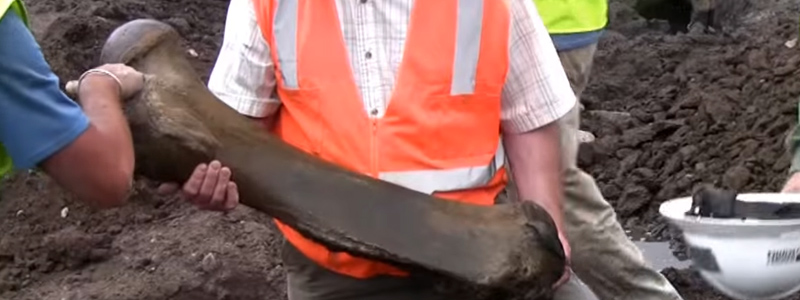7 Fossil Sites in South Dakota & Nebraska
The Fossil Freeway is a unique highway passageway between Kimball in Nebraska’s Panhandle and The Black Hills in Rapid City, South Dakota, where visitors will experience the awe of our vibrant fossil history. Step back in time as you visit many great sites along this journey, which exhibit rare and remarkable treasures from our prehistoric past.
“{This} is an incredibly rich area for prehistoric finds,’’ says Mark Harris, associate director of the University of Nebraska State Museum in Lincoln.
Mammoth Site of Hot Springs
A major paleontological discovery in the Black Hills of South Dakota provides new knowledge about the mysterious and fascinating prehistoric world, helping to fill in previous gaps.
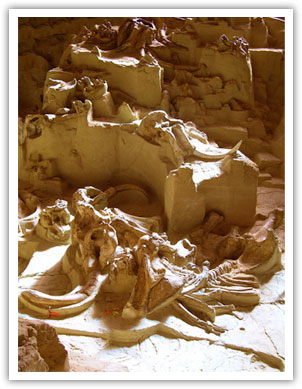 Once, gigantic mammoths, ancestors of the majestic elephants of today, roamed freely in the High Plains of North America. A repository of their remains, along with other kinds of animals now extinct, lay entombed in the earth until their discovery 26,000 years later at what is now called the Hot Springs Mammoth Site. The fossil remains of more than 100 mammoths reside there in primary context–that is, the skeletons of the animals are still located where they died. Since the discovery in 1974, scientists have excavated the remains of 58 mammoths that include 55 Columbian and 3 woolly mammoths, as well as over 80 other species of animals and plants.
Once, gigantic mammoths, ancestors of the majestic elephants of today, roamed freely in the High Plains of North America. A repository of their remains, along with other kinds of animals now extinct, lay entombed in the earth until their discovery 26,000 years later at what is now called the Hot Springs Mammoth Site. The fossil remains of more than 100 mammoths reside there in primary context–that is, the skeletons of the animals are still located where they died. Since the discovery in 1974, scientists have excavated the remains of 58 mammoths that include 55 Columbian and 3 woolly mammoths, as well as over 80 other species of animals and plants.
The skeletons were uncovered in what was once a prehistoric sinkhole that formed when limestone deposits within the earth’s surface dissolved in water from underground springs. The land then collapsed, and the resulting hole filled with water, luring the huge mammoths to drink or feed on vegetation. Once in the water, they could not climb back up the slippery, steep incline because of their body mass and weight, so they remained trapped forever in the sinkhole.
The Mammoth Site’s 36,000 square foot visitor center is climate controlled and universally accessible. A kid’s activity area offers young scientists “hands-on” learning. You can also get a glimpse behind the scenes at the Mammoth Site’s new laboratory.
Year-round guided tours offer visitors a display of bones found in situ (in original position) and an opportunity to experience a living exhibit of paleontology activity. Allow at least an hour to take the tour and view other exhibits. While you’re there, be sure to browse the extensive book/museum store that features many unique souvenirs for your entire family.
The Mammoth Site serves as a model of success for other paleontological and archeological sites.
The Mammoth Site
1800 US-18 BYP
Hot Springs, SD 57747-0692
Telephone: (605) 745-6017
Website: www.mammothsite.org
Toadstool Geologic Park
Toadstool Geologic Park gets its name from the bulky sandstone blocks balanced on seemingly impossibly narrow pedestals of sediment seen throughout the area. The sandstone blocks, many of which still bear tracks of extinct animals, are remnants from a river that flowed through the area over 30 million years ago, and subsequent weathering has broken the sandstone down into blocks.
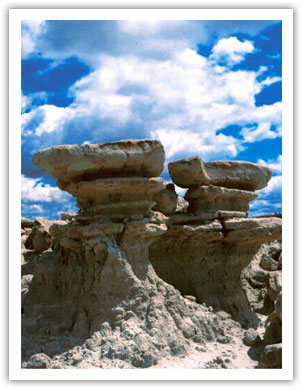 The rocks giving Toadstool its moonscape appearance were deposited by wind and streams between 45-26 million years ago. Volcanic ash from the west coast being driven by the prevailing winds also came to rest in northwest Nebraska. The alternating reddish and greenish bands of color that appear in the area are due to soil development during the wet or dry seasons when the ash was deposited. Red-tinged layers formed during wet seasons when iron in the ash oxidized or “rusted,” while the greenish layers indicate soil formation during dry seasons.
The rocks giving Toadstool its moonscape appearance were deposited by wind and streams between 45-26 million years ago. Volcanic ash from the west coast being driven by the prevailing winds also came to rest in northwest Nebraska. The alternating reddish and greenish bands of color that appear in the area are due to soil development during the wet or dry seasons when the ash was deposited. Red-tinged layers formed during wet seasons when iron in the ash oxidized or “rusted,” while the greenish layers indicate soil formation during dry seasons.
This volcanic ash accumulating also explains why the flora and fauna are so precisely fossilized. Silica minerals dissolved from the ash-filled the pore spaces in the skeletons to strengthen the bone, allowing it to withstand weathering.
Extinct animals preserved at Toadstool Geologic Park include tortoises, rhinos, birds (ducks, shorebirds, herons) , saber-toothed cats, early dogs, large pig-like animals, oreodonts (sheep-like), small tusked deer, early 3 toed horses, early camels, brontotheres (8 ft tall rhino-like), bats, snakes, rodents, and lizards–just to name a few. During this time, grasses were not much established in the area, so the herbivores were browsers. The climate nearly 45 million years ago appears to have been humid subtropical, but by 26 million years ago the climate was very dry.
If you enjoy natural wonders and have a taste for living history preserved in rock, hike Toadstool Geologic Park. The site includes a camping and picnic area.
Toadstool Geological Park
in Oglala National Grassland
Harrison, NE 69346
Telephone: (308) 432-0300
Hudson-Meng Bison Bonebed
The Pine Ridge of Nebraska holds one of the most important Paleoindian (the first documented Americans) archaeological sites yet discovered anywhere on the Great Plains, the Hudson-Meng site, located in a small sheltered valley that served as an occasional home to several of the earliest cultures to live in this part of North America between about 10,200 and 11,200 years ago. The natural resources of the valley—a flowing spring, wooded groves, and vast surrounding grasslands—attracted both herds of bison and groups of hunter-gatherers to the place for thousands of years. And the ways that people and bison interacted at the site have created an archaeological mystery about how people lived after the Ice Age.
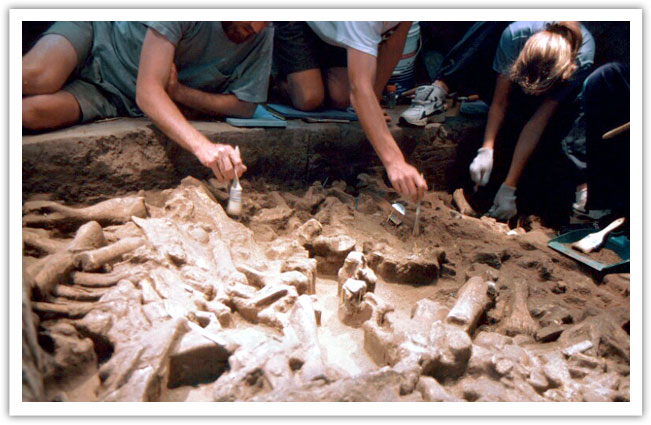
Discovered in 1954 during the construction of a stock pond, the site was originally excavated in the 1970s and interpreted as the largest Paleoindian-age bison kill site ever discovered, with as many as 600 animals having been taken in one hunt. Subsequent research during the 1990s led to differing interpretations as archaeologists then suggested that the bison died from multiple events. Some theorized that the main portion of the bonebed may not represent a hunting site at all but that the animals may have died during a natural event such as a raging prairie grass fire. Current researchers at the site, through the use of modern scientific techniques, are still attempting to solve the mystery!
A visit to the Hudson-Meng Education and Research Center will allow you to view a contemporary archaeological excavation in progress. In 1997, a climate-controlled enclosure was completed over the central portion of the bonebed, and the site is open to the public each summer from Memorial Day to Labor Day. When you visit, you’ll find interpretive displays, guided tours, and interactive science activities to help you understand why this is such an important discovery, and you are even encouraged to develop your own theories about what might have happened to the bison.
The site is located in Nebraska’s Oglala National Grassland administered by the Nebraska National Forest, on the shoulder of the picturesque Pine Ridge, overlooking the Black Hills of South Dakota. As an added bonus, it’s only a few miles (or a short hike) to the moonscape of Toadstool Geologic Park.
Hudson-Meng Bison Kill Bed
Harrison, NE 69346
Telephone: (308) 432-0300
Website
Trailside Museum – Fort Robinson State Park
Wonder as you view the skeletal remains of two huge mammoths lying as they have since the Ice Age – tragically locked together in combat! More than 10,000 years ago, a pair of “testosterone-crazed” bull mammoths crossed paths on the high plains in what would one day be western Nebraska. The two Columbian mammoths battled for mating rights. However, fate thwarted desire when their tusks permanently intertwined. After an epic struggle, the mammoths fell and tragically perished.
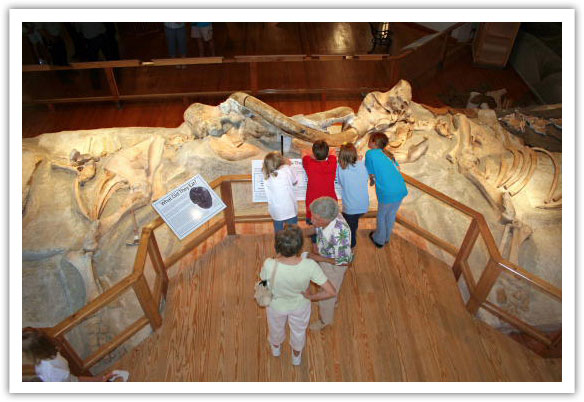
Preserved under layers of sediment cascading off the Little Badland formations, the dueling titans were discovered in the summer of 1962 and can now be seen as they were found during that remarkable excavation. Also witness the dramatic fight depicted in a huge, awe-inspiring mural, and explore a wide variety of other rare Nebraska fossils such as an ancient rhino, giant tortoise, mosasaur skull, full-standing mammoth, and more! Shop for treasures for the entire family in our museum store and gallery. Find books, posters, toys, jewelry, souvenirs, Native American arts & crafts, and more!
Come visit us for an experience you will never forget. This is a one-of-a-kind fossil discovery not found anywhere else in the world!
Trailside Museum
Fort Robinson State Park
Chadron, NE 69337
Telephone:
{308) 665-2929
Website
Agate Fossil Beds National Monument
Under a sky, hazy with volcanic ash, strange animals once roamed the prairie now called Western Nebraska. Details of their intriguing story can be found in a dramatic Visitor Center at Agate Fossil Beds National Monument. Here, you can meet the small rhinoceros of its day, the Menoceras, which died in abundance, creating a huge fossil bonebed famous since its discovery in the early 1900s. Other animals attracted to the death scene were even more bizarre, such as the huge hog-like Dinohyus, larger than a buffalo, which dominated all life forms with its fearsome teeth and angular skull. The long-necked Moropus, on the other hand, combined features of many different contemporary animals from horse to bear to sloth.
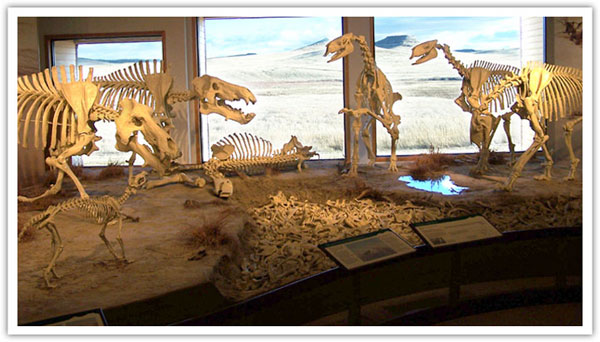
Another intriguing animal, the land-dwelling beaver, Palaeocastor, dug perfect spiral burrows which have likewise become fossilized over time, provoking the name “Devil’s Corkscrews.”
The animals found at Agate Fossil Beds National Monument came from some 19-21 million years ago during a longer time period described by scientists as the early Miocene Epoch (5-23 million years ago) when the landmass was drying out and abundant animals responded to a new food source as grasslands replaced forest and jungle. Some of these creatures, though slightly different anatomically, resemble those of today. Others came in peculiar shapes and sizes, now long extinct, and truly reflect the monsters of yesteryear, whether real or imagined. These are the animals that replaced the dinosaurs.
The Visitor Center features an informative film and various displays, along with a life-size diorama that depicts the ancient animals and the theories concerning their existence. Outside, trails lead to the fossil areas, with a few of the corkscrew burrows exposed, while most fossils still remain hidden in the ground. The Visitor Center also features the story of the fossil discoverer, rancher James Cook, an interesting man whose friendship with High Plains tribes of Native Americans unfolds through a unique collection of American Indian artifacts in the Cook Gallery.
Agate Fossil Beds National Monument
301 River Rd.
Harrison, NE 69346
Telephone: (308) 668-2211
Website
Scott Bluff National Monument
Scotts Bluff National Monument protects nearly 3,000 acres along the North Platte River in the western portion of the Nebraska panhandle, now a monument in honor of the promontory bluff which acquired its name from an early mountain man named Hiram Scott, who was, according to legend, abandoned and eventually died in the area. Almost immediately after his death, the bluffs along the North Platte River came to be known as Scott’s Bluffs. A modern Visitor’s Center provides interpretive information about the area’s history, as well as more information about the unique and compelling geological finds within the monument’s boundaries.
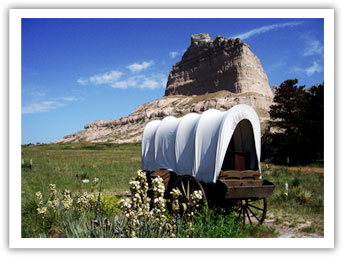 The monument district includes the bluff itself which rises 800 feet above the river, exposing more geological time than anywhere in the state. The exposed layers of rocks date from 33 million years before the present (BP) in the national monument’s badlands to 22 million years BP on the summit.
The monument district includes the bluff itself which rises 800 feet above the river, exposing more geological time than anywhere in the state. The exposed layers of rocks date from 33 million years before the present (BP) in the national monument’s badlands to 22 million years BP on the summit.
During the early to middle Cenozoic, clastic and volcaniclastic sediments from the Rocky Mountain region came to be deposited in low-lying areas (lakes, streams, and floodplains) across the Great Plains. Subsequent uplift and fluvial erosion of the area left behind fossiliferous exposure of Oligocene age, and this activity shaped the land we see today.
Most of the national monument’s fossils are located in its badlands area, where sandstone and siltstone layers of the Orella and Whitney Members of the Brule Formation lie exposed. Silica glass shards are mixed in with the rock layers, leading to a belief that volcanic eruptions may have caused an occasional mass die-off of animals. Fossils of ancient horses, camels, rhinos, oreodonts, tortoises, rodents, and trace fossils, such as animal burrows can be found. Several of Scotts Bluff’s fossils have become “type” or indicator fossils.
There are no established trails into the badlands area, but the area is open to the public. Removing any fossil from its surrounding rock and fossil collecting is prohibited.
Scotts Bluff National Monument
190276 Old Oregon Trail
Gering, NE 69341
Telephone: (308) 436-9700
Website: www.nps.gov/scbl
Wildcats Hills State Recreation Area
The Wildcat Hills Nature Center serves as the southern gateway to the Fossil Freeway. Paleontologists working at the nearby Millennium’s End Quarry (discovered in 1999) have uncovered a wealth of small mammal fossils, many of which are depicted in the Nature Center’s 16-foot mural painted by world-famous muralist Jan Vriesen. The mural depicts life as it would have been 23 million years ago in what is now western Nebraska, displaying ferns, bamboo, and woodlands containing camels, 3-toed horses, rhinos, sling-shot horned deer, tapirs, and other animals. Some of their lineages have since died out, others have evolved into modern creatures, and some of the animals were much the same as they are in the present day. The quarry’s fossils were captured in a bend of a very fast-moving river, which wound its way through what is today’s Wildcat Hills.
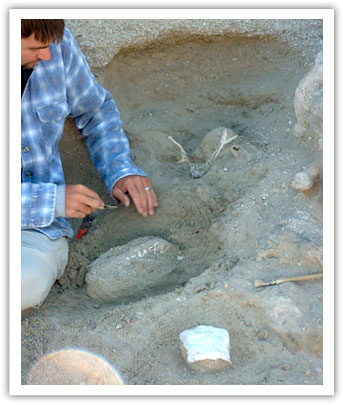 A unique feature available at the Nature Center is a 25 million-year-old fossil discovered in the Nebraska panhandle in 1932 by renowned paleontologist Loren Eiseley. As though gazing stoically from 25 million years ago, two sabertooth cats, Nimravids, remain intertwined in death.. One cat’s canine tooth is embedded in the other cat’s shoulder blade, the fatal battle from with neither combatant ever escaped. Another painting by Vriesen depicts the death scene. Other fossil replicas from the Nebraska State Museum of ancient elephants, large lions, and rhinos that once roamed Nebraska can also be found at the Center. Youth will enjoy the center’s interactive simulated fossil dig site where they can try their hand at excavating fossils on their own.
A unique feature available at the Nature Center is a 25 million-year-old fossil discovered in the Nebraska panhandle in 1932 by renowned paleontologist Loren Eiseley. As though gazing stoically from 25 million years ago, two sabertooth cats, Nimravids, remain intertwined in death.. One cat’s canine tooth is embedded in the other cat’s shoulder blade, the fatal battle from with neither combatant ever escaped. Another painting by Vriesen depicts the death scene. Other fossil replicas from the Nebraska State Museum of ancient elephants, large lions, and rhinos that once roamed Nebraska can also be found at the Center. Youth will enjoy the center’s interactive simulated fossil dig site where they can try their hand at excavating fossils on their own.
The Nature Center also provides a collection of local owls, raptors, songbirds, and mammals. In the main building’s center stands a 27-foot Ponderosa Pine, which extends through two stories of the building. The interior of a beehive can be viewed, along with the beautiful vistas of the Wildcat Hills area.
A NE State Park permit is required on all vehicles for both the Recreation Area and Nature Center: $4/day, $20/annual. There is also a primitive campground within the park. Overnight camping fee $7.
Wildcats Hills State Recreation Area
210615 NE-71
Gering, NE 69341
Telephone: (308) 436-3777
